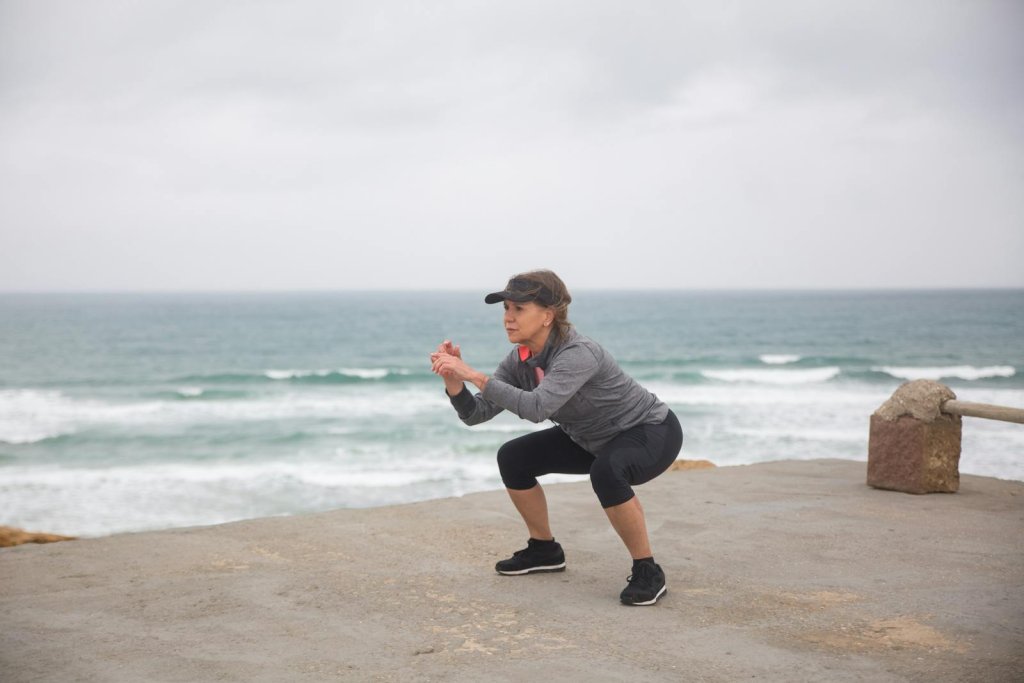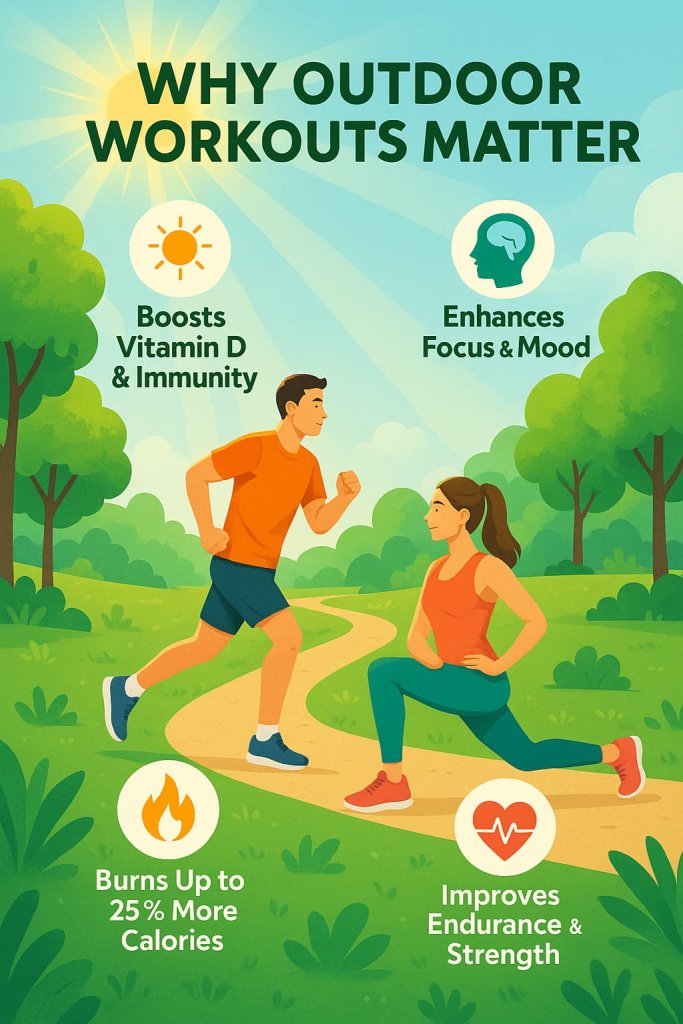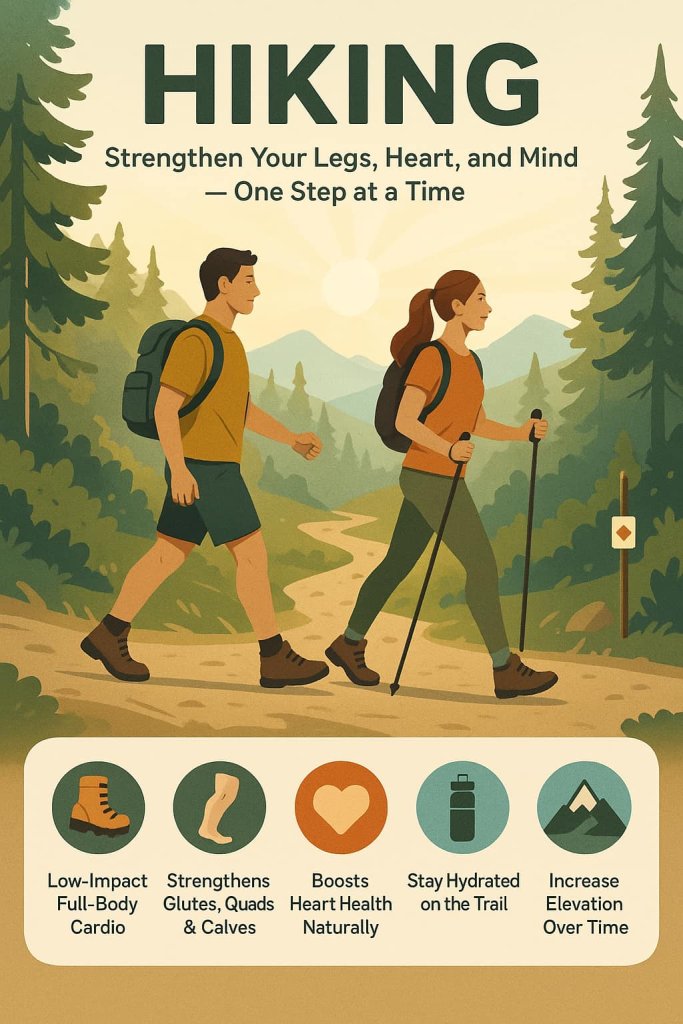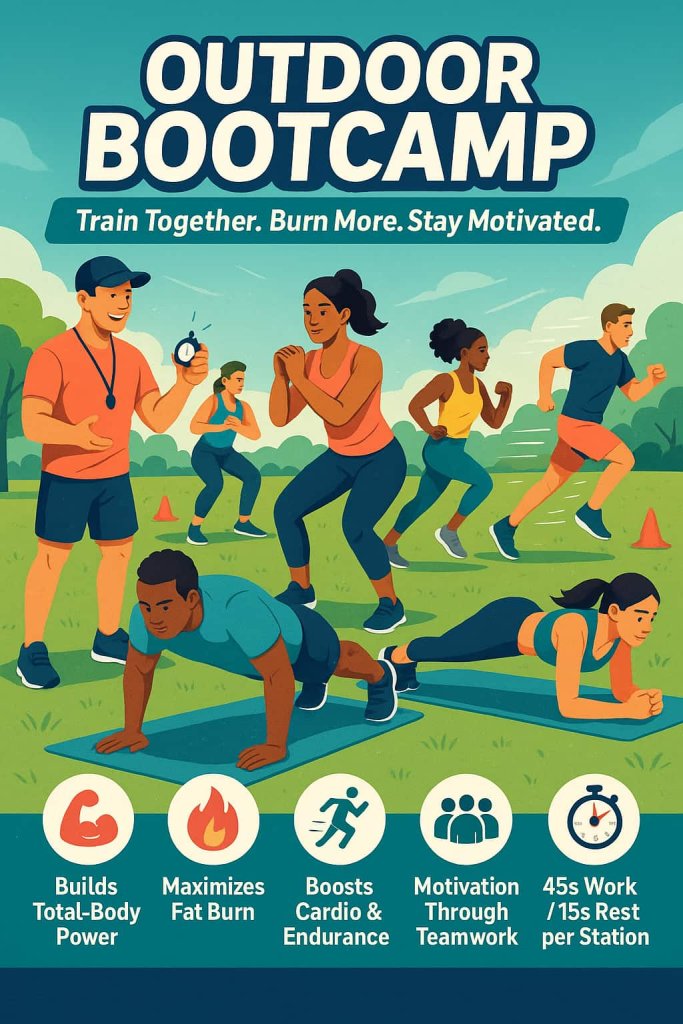Outdoor workouts are one of the most effective and enjoyable ways to burn fat, build strength, and naturally boost your mood. Research from Frontiers in Psychology (2024) shows that exercising outdoors increases energy, reduces stress hormones, and enhances long-term consistency compared to indoor workouts.

Whether you’re in a park, at the beach, or in your backyard, these exercises deliver full-body results with minimal equipment.
Why Outdoor Workouts Matter
Working out in nature provides both physical and mental health benefits that go beyond the gym. According to research, outdoor exercise may improve vitamin D levels, support immune health, and enhance sleep quality due to natural light exposure (Bârsan et al., 2023).
A Nature Scientific Reports (2023) study found that a 15-minute walk outdoors improves attention and brain performance more than the same indoor walk.

Key Benefits
- Burns up to 25% more calories due to uneven terrain and natural resistance
- Enhances mental clarity, focus, and mood through exposure to sunlight and fresh air
- Boosts cardiovascular endurance, strength, and balance
- Increases adherence and motivation — you’re more likely to stick with it!
15 Best Outdoor Workouts
These 15 outdoor workouts combine strength, cardio, and endurance to help you burn fat, build lean muscle, and boost your energy naturally.
Each exercise is simple, equipment-free, and designed to make the most of nature’s resistance and fresh air.
1. Hill Sprints
Why it works:
Sprinting uphill builds explosive lower-body power, improves cardiovascular endurance, and burns calories at a high rate while being easier on your joints than flat sprints.
Muscles worked:
Glutes, hamstrings, quads, calves, and core.
How to do it:
- Find a hill with a 5–10% incline.
- Warm up with 5 minutes of light jogging or dynamic stretches.
- Sprint up the hill for 20–30 seconds at 80–90% effort.
- Walk or jog back down for recovery.
- Repeat 6–8 rounds.
Trainer Tip:
Lean slightly forward, keep your core tight, and drive your knees powerfully with each stride.
2. Park Bench Step-Ups
Why it works:
A functional move that improves balance, strengthens the legs, and tones the glutes using only your bodyweight.
Muscles worked:
Glutes, quadriceps, hamstrings, and calves.
How to do it:
- Stand facing a sturdy park bench.
- Place your right foot on the bench.
- Press through your heel to lift your body upward.
- Bring your left knee up to hip level, then step back down.
- Alternate legs for 12–15 reps each, completing 3 sets.
Trainer Tip:
Hold water bottles or a backpack for added resistance and intensity.
3. Outdoor Circuit Training
Why it works:
Combines strength and cardio in one workout to build muscle and torch fat efficiently.
Muscles worked:
Full body — chest, shoulders, legs, arms, and core.
How to do it:
- Choose 4–5 exercises (e.g., squats, push-ups, burpees, mountain climbers, planks).
- Perform each for 40 seconds, rest 20 seconds.
- Complete 3–4 total rounds.
- Rest 60–90 seconds between rounds.
Trainer Tip:
Alternate upper- and lower-body moves to maintain energy and reduce fatigue.
4. Trail Running
Why it works:
Engages stabilizer muscles and improves balance, agility, and endurance due to uneven terrain.
Muscles worked:
Glutes, quads, hamstrings, calves, and core.
How to do it:
- Select a safe trail with gentle inclines and stable footing.
- Run at a moderate pace for 20–40 minutes.
- Keep strides short and light to protect your knees and ankles.
- Focus on posture and breathing rhythm.
Trainer Tip:
Wear trail shoes with good grip and stay alert to your surroundings.
5. Bodyweight Tabata
Why it works:
Short bursts of maximum effort elevate metabolism and improve both aerobic and anaerobic fitness.
Muscles worked:
Full body — especially legs, chest, shoulders, and abs.
How to do it:
- Choose one or two moves (e.g., jump squats, push-ups).
- Perform 20 seconds of all-out effort.
- Rest 10 seconds.
- Repeat for 8 total rounds (4 minutes).
- Rest 1–2 minutes and switch exercises.
Trainer Tip:
Stay explosive but controlled — maintain perfect form throughout.
6. Jump Rope Intervals
Why it works:
Improves cardio endurance, coordination, and footwork while strengthening the lower legs.
Muscles worked:
Calves, quads, shoulders, forearms, and core.
How to do it:
- Warm up with 30 seconds of slow jumps.
- Jump at a moderate pace for 60 seconds.
- Rest for 30 seconds.
- Repeat for 10–12 rounds.
- Mix in double-unders or side swings for variety.
Trainer Tip:
Keep elbows close to your sides and land softly to protect your joints.
7. Stair Runs
Why it works:
Enhances leg power, balance, and endurance while providing an intense cardiovascular challenge.
Muscles worked:
Glutes, quads, hamstrings, calves, and core.
How to do it:
- Find a safe outdoor staircase or bleachers.
- Sprint up the stairs with strong, quick steps.
- Walk down for recovery.
- Repeat for 10–15 minutes.
- Option: Add stair hops or skips for variety.
Trainer Tip:
Engage your core, maintain upright posture, and push off your heels.
8. Resistance Band Workout
Why it works:
Creates constant tension on muscles for improved strength and stability without weights.
Muscles worked:
Shoulders, arms, back, glutes, and legs.
How to do it:
- Anchor a resistance band around a pole or tree.
- Perform 12–15 reps each of squats, rows, chest presses, and curls.
- Rest 30 seconds between moves.
- Complete 3 rounds.
Trainer Tip:
Focus on slow, controlled movements — tension in both directions matters most.
9. Beach Workouts
Why it works:
Sand adds resistance, improving balance, joint stability, and calorie burn.
Muscles worked:
Glutes, quads, calves, hamstrings, shoulders, and core.
How to do it:
- Perform 30-second sprints on sand.
- Add bodyweight moves like lunges, bear crawls, and push-ups.
- Complete 4–5 rounds of alternating strength and cardio.
- Rest 1 minute between rounds.
Trainer Tip:
Train barefoot if safe — it strengthens feet and ankles naturally.
10. Outdoor Yoga
Why it works:
Boosts flexibility, focus, and mood while lowering stress and cortisol levels.
Muscles worked:
Core, hamstrings, glutes, shoulders, and back.
How to do it:
- Find a quiet outdoor space.
- Start with gentle poses like Downward Dog and Warrior II.
- Flow through 3–4 sequences for 20–40 minutes.
- Focus on breathing and mindful movement.
Trainer Tip:
Use a towel or thicker mat for uneven ground and bring water for longer sessions.
11. Bodyweight Strength Circuit
Why it works:
Improves muscle endurance and full-body tone using minimal equipment.
Muscles worked:
Legs, chest, shoulders, arms, back, and abs.
How to do it:
- Perform 15 reps each of squats, push-ups, planks, and lunges.
- Rest 60 seconds between exercises.
- Complete 3–4 total rounds.
- Keep movement tempo steady and controlled.
Trainer Tip:
Add a weighted vest or backpack as you progress for overload.
12. Hiking
Why it works:
A low-impact cardio activity that builds lower-body strength and boosts heart health.
Muscles worked:
Glutes, quads, calves, hamstrings, and core.

How to do it:
- Choose a moderate trail with elevation.
- Walk at a steady pace for 45–90 minutes.
- Take short breaks to hydrate and enjoy the view.
- Gradually increase trail difficulty over time.
Trainer Tip:
Maintain an upright posture and use trekking poles to reduce strain on knees.
13. Kayaking or Paddleboarding
Why it works:
Engages upper body and core while improving balance and coordination on water.
Muscles worked:
Core, shoulders, back, arms, and lats.
How to do it:
- Sit or stand tall on your kayak or paddleboard.
- Paddle evenly on both sides for 20–45 minutes.
- Keep core tight to stabilize your torso.
- Maintain consistent rhythm for endurance.
Trainer Tip:
Engage your torso during each stroke — power comes from rotation, not just arms.
14. Outdoor Bootcamp
Why it works:
Blends teamwork, strength, and cardio to maximize fat burn and motivation.
Muscles worked:
Full body — chest, legs, shoulders, arms, and abs.

How to do it:
- Set up 5–6 stations: push-ups, squats, lunges, burpees, sprints, and planks.
- Work at each for 45 seconds, rest 15 seconds.
- Complete 3–5 total rounds.
- Rest 1 minute between circuits.
Trainer Tip:
Use group energy to stay motivated — train with friends or a local bootcamp class.
15. Cycling
Why it works:
Builds leg endurance, strengthens the lower body, and enhances cardiovascular fitness with minimal joint stress.
Muscles worked:
Quads, glutes, hamstrings, calves, and core.
How to do it:
- Choose a scenic road or trail.
- Cycle for 30–60 minutes at moderate intensity.
- Maintain 80–90 rpm cadence.
- Mix steady rides with short sprints for variation.
Trainer Tip:
Adjust seat height so your knees stay slightly bent at the bottom of each pedal stroke.
How to Get the Most from Outdoor Workouts
- Warm Up: 5–10 minutes of light jogging, arm circles, and dynamic stretches.
- Hydrate: Bring water, especially in warm weather.
- Protect Yourself: Use sunscreen and wear breathable gear.
- Track Progress: Use a fitness app or smartwatch for heart rate and calories.
- Mix It Up: Alternate cardio, strength, and mobility days for balance.
Common Mistakes to Avoid
- Skipping warm-ups or stretching
- Overtraining without rest days
- Ignoring hydration or sun protection
- Using poor form on uneven terrain
FAQ
1. Are outdoor workouts as effective as gym workouts?
Yes — studies show outdoor workouts can enhance motivation and calorie burn due to natural resistance and terrain variation.
2. What time of day is best for outdoor exercise?
Early morning or late afternoon — temperatures are cooler and air quality is better.
3. Can I build muscle outdoors without equipment?
Absolutely. Bodyweight training and resistance bands can build strength effectively.
4. How many days a week should I do outdoor workouts?
Aim for 3–5 sessions per week, alternating cardio and strength focus.
5. Are outdoor workouts safe for beginners?
Yes. Start with walking, bodyweight exercises, and low-impact circuits.
6. Do outdoor workouts really improve mood?
Yes — exposure to sunlight increases serotonin and reduces cortisol.
7. How do I stay consistent?
Set a schedule, choose scenic routes, and vary your workouts to keep them fun.
Conclusion
Outdoor workouts are the perfect combination of fitness, freedom, and fun. They challenge your body, lift your mood, and reconnect you with nature — all while helping you burn fat and build real-world strength.
Start small: choose one or two of these 15 workouts, commit to 3 sessions a week, and experience the transformation firsthand.
References
- Nature Scientific Reports (2023): Outdoor vs. indoor—15-minute bout improves attention & working memory
Link: Exercising is good for the brain but exercising outside is better. - American Heart Association (2024): Evidence-based weekly activity targets
Link: AHA Recommendations for Physical Activity in Adults. - AHA Infographic (2024): Reader-friendly “Fit in 150+” visual
Link: How much physical activity do you need? (AHA Infographic). - Harvard Health (2024): Exercise types with the strongest antidepressant effects
Link: Certain exercises may offer effective treatment for depression. - Frontiers in Sports & Active Living (2024): Green-exercise review (balanced YMYL evidence)
Link: Reassessing green exercise research: unveiling methodological gaps and pathways for progress. - Health Psychology Review (2024): Outdoor vs. indoor—enjoyment higher outdoors
Link: Acute effects of outdoor versus indoor exercise: a systematic review. - Nature Scientific Reports (2024): Nature walk reduces attention load (EEG) & boosts affect
Link: The influence of a walk in nature on human resting brain function
